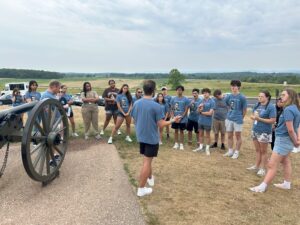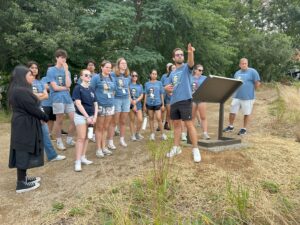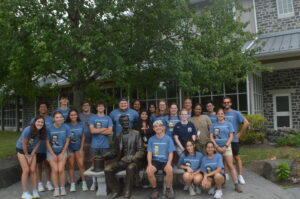On Saturday, the group went to Gettysburg National Military Park to learn about the Civil War battle there. We first stopped at the Eternal Peace Monument at the park’s north end. Here, Cooper Wingert, the tour leader, highlighted the events that preceded the battle. Cooper discussed the Confederate invasion of Pennsylvania, the shelling of Carlisle, and the march onto Gettysburg from here. Afterwards, we made our way into the park towards McPherson Ridge where Cooper then detailed the first day of the battle. He described how the US forces may have lost their initial positioning but set themselves up for success later in the battle by fortifying the high ground south of the town.
Then, we made our way over to the Virginia Memorial, where we talked a bit about the Confederate army’s strategy and their relationships with both the enslaved people that they brought into Pennsylvania, and their harassment of Pennsylvania’s free-Black population in Chambersburg. Finally, Cooper and Professor Pinsker brought up the question as to how we should remember the monuments at Gettysburg, and whether monuments like the Virginia Memorial are too “glorifying” of the Confederate troops, who were ultimately fighting in the name of slavery.
Our next stop was at Little Round Top, where Cooper taught us about the second day of the battle. He explained how the Confederate strategy of flanking the US defenses was nearly successful, but because of the heroism of the US army’s southern flank, they were able to survive the Confederate attempts at taking the high ground. Additionally, the students also got to take plenty of pictures at the New York Monument, which gives a great view of the battlefield itself.
Then we made our way over to Cemetery Ridge, where we learned about the final day of the battle. Cooper described Pickett’s charge, the reasoning behind General Robert E. Lee’s gamble by ordering the charge, and the heroism of the US soldiers who fought off the Confederate charge. Cooper also described the aftermath of the battle, including the retreat back to Virginia, and President Lincoln’s reaction to General George Meade’s missed opportunity to beat Lee’s forces during the retreat. Professor Pinsker also gave a discussion about the Gettysburg address in the National Cemetery, which is where Lincoln gave his famous address when dedicating the site.
After the tour, we went to the visitors’ center for lunch, saw the Gettysburg film, viewed the famous Cyclorama of the battle, and got to tour the museum and gift shop there. Some students (and Cooper and Sarah from our staff) even got to wear replica uniforms of the US troops and got to read up on more information at the museum (I did attempt to wear the uniform but failed miserably). Finally, we headed home after a long day where we had a relaxing night at the dorms.




Leave a Reply